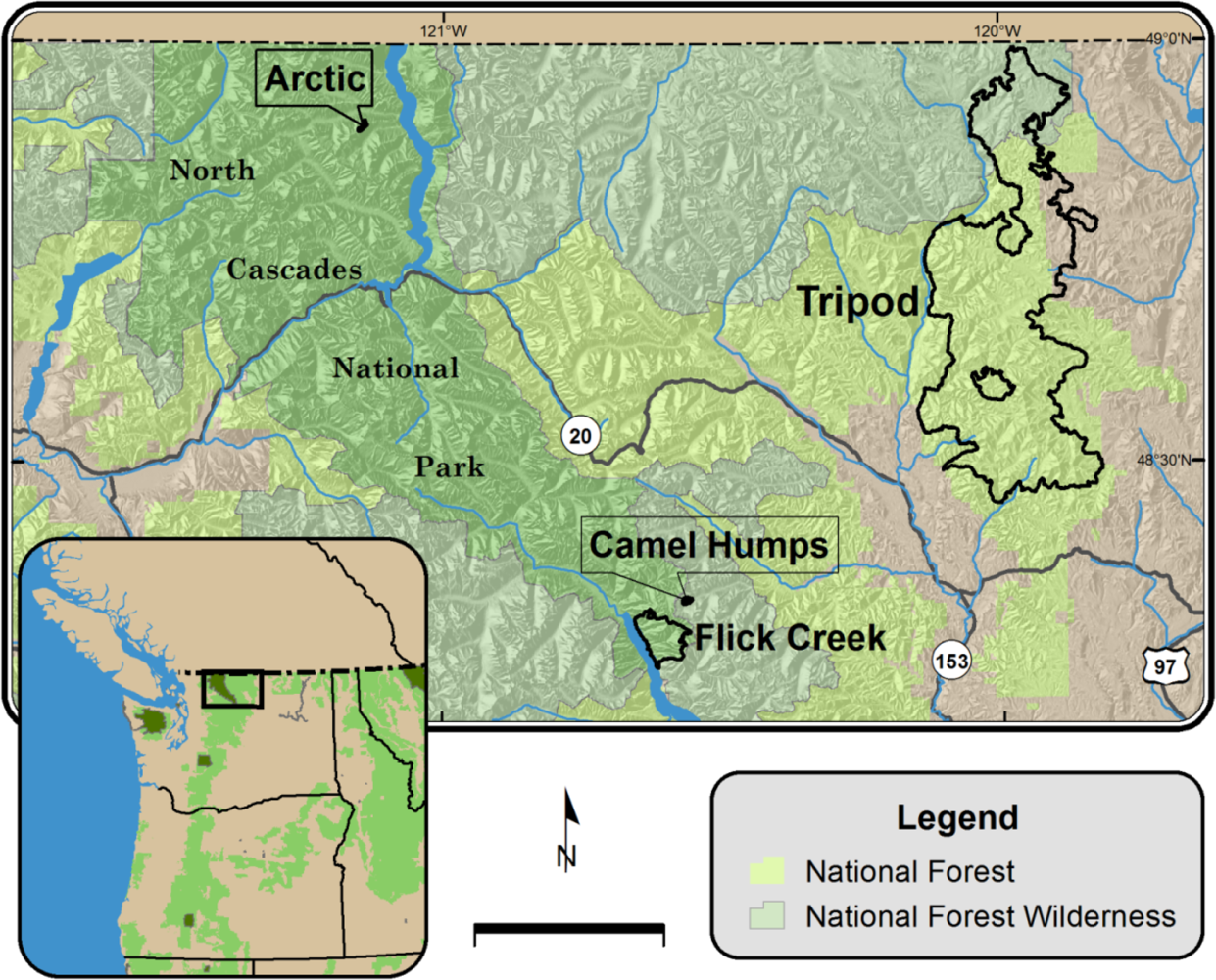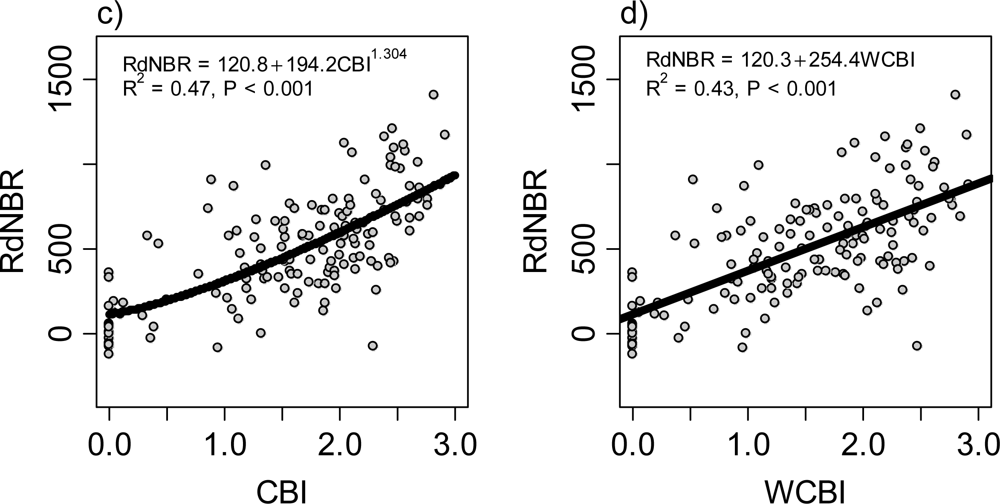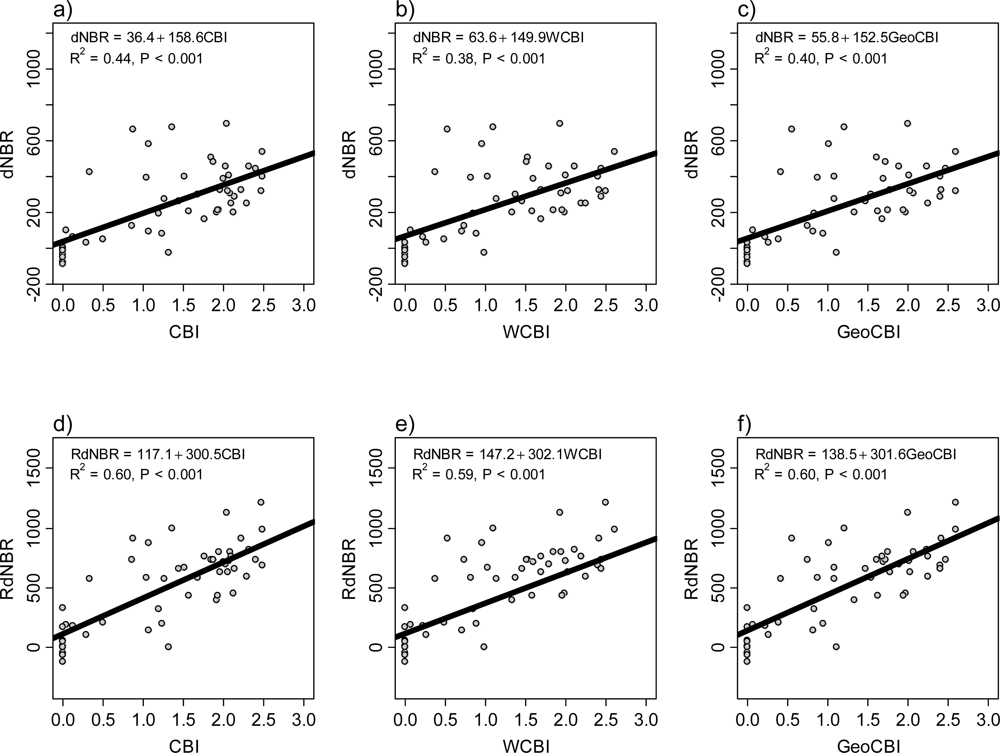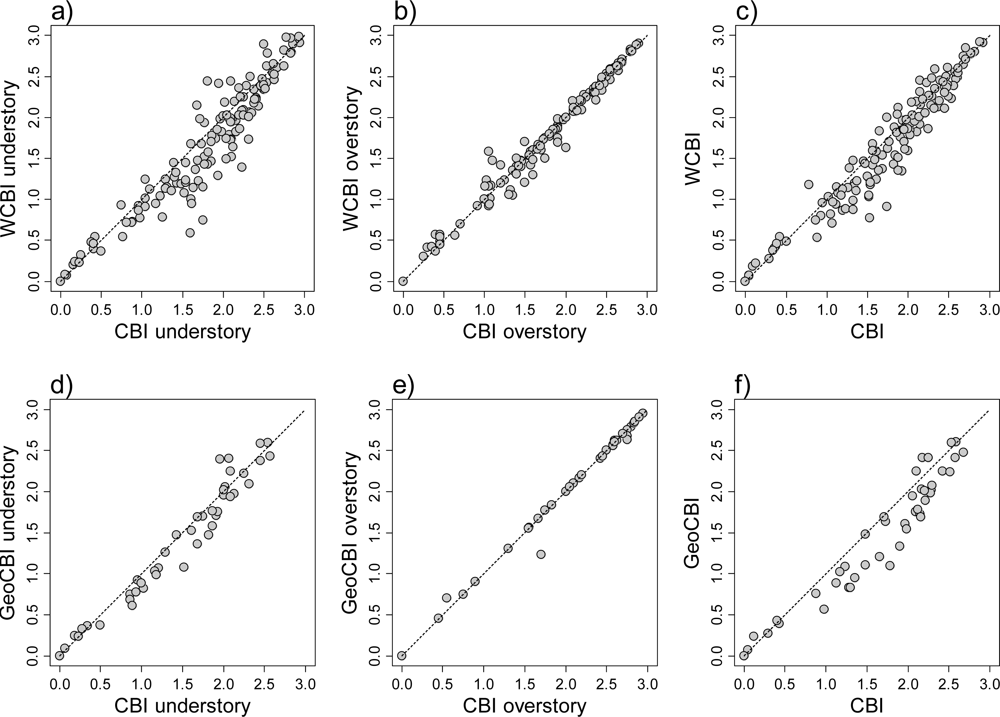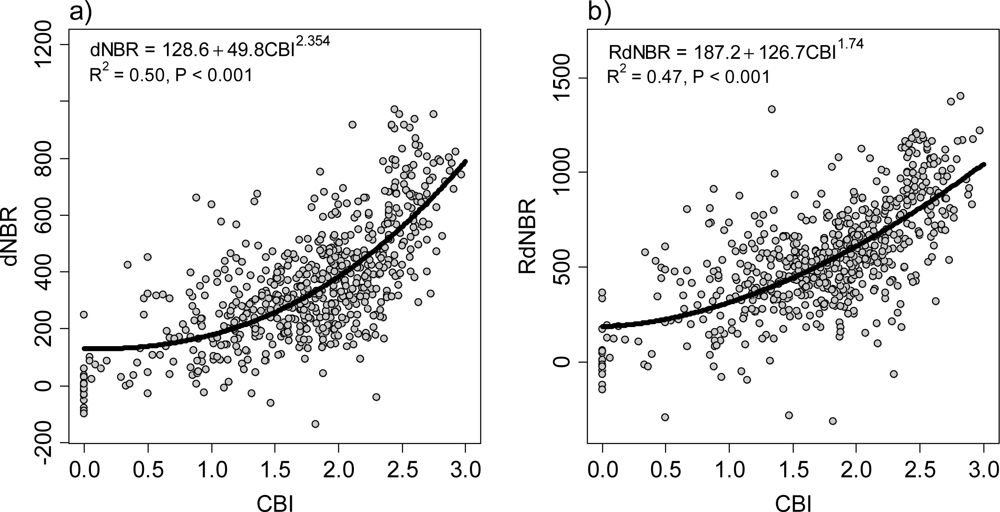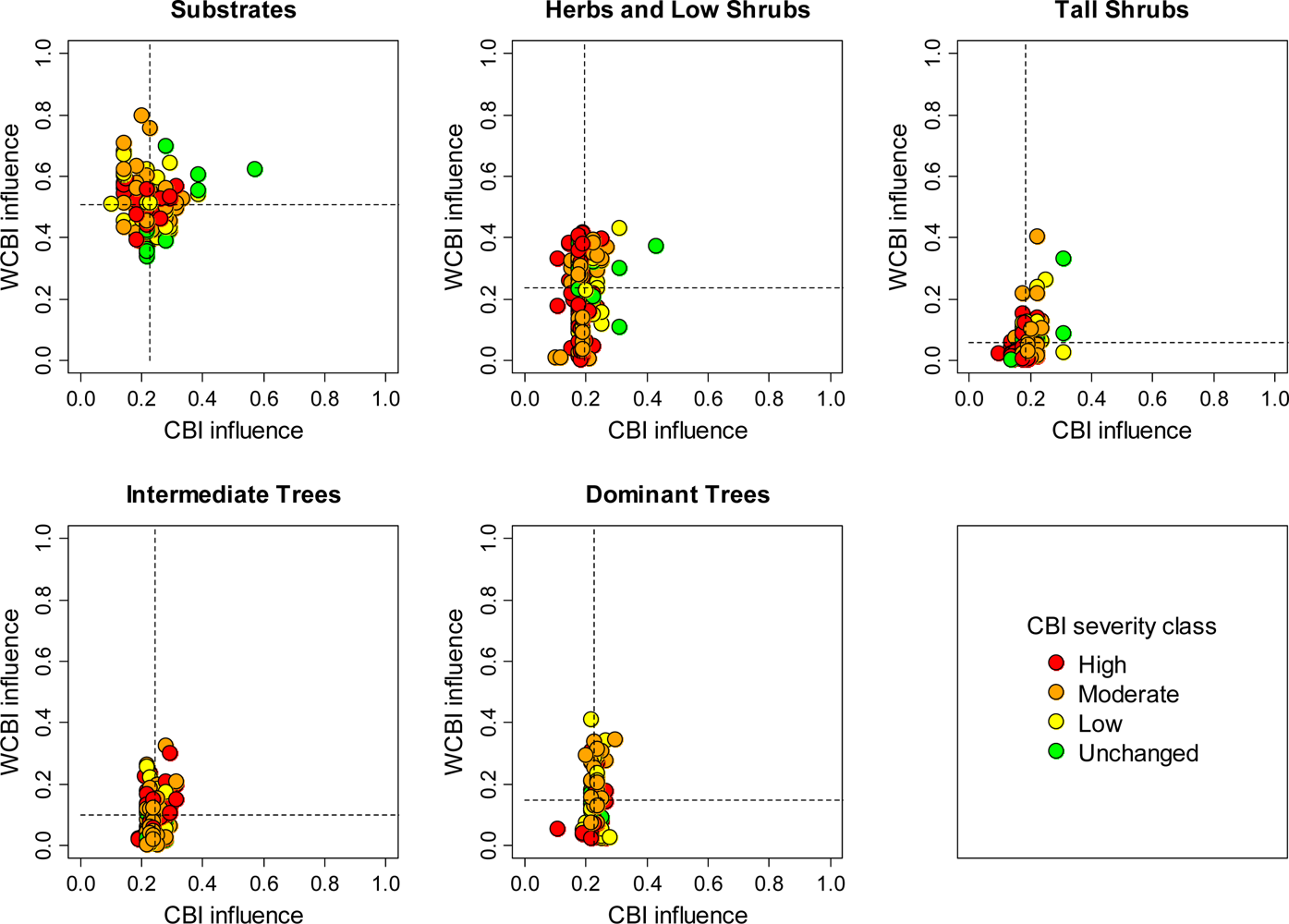We also compare three methods of measuring burn severity in the field: the Composite Burn Index, (CBI), which was specifically developed to validate and produce regionally-based classification schemes of remotely sensed burn severity data [
3], and two variations of a methodical refinement of the CBI based on the Geometrically structure Composite Burn Index (GeoCBI), which has been used successfully in Spain and Portugal [
4,
5]. Regional empirical validation of burn severity indices is necessary because previous research has shown that the relationships between remotely sensed and field-based assessments vary among regions [
6]. Regressions that predict remotely sensed burn-severity from field measurements can be used to classify the remotely sensed data into distinct severity classes [
1,
2]. Although some information is lost in the classification process, categorical images facilitate: (1) visual interpretation of images; (2) comparisons of multiple fires or fires from multiple regions; (3) analysis of the spatial context and spatial pattern of severity; (4) spatially explicit predictions of the impacts of the fire (
i.e., soil erosion, water quality, succession, and carbon emissions); and (5) targeted management responses to those impacts.
In addition to providing a test of the transferability of new methods to a novel location, our results also provide an empirically derived classification scheme for two commonly used remotely sensed indices of burn severity. This classification scheme should be applicable to ecologically similar areas in the Cascade Range, from northern Oregon to southern British Columbia. No empirical validation of the relationship of the two burn severity indices with field data has been conducted in the Cascade Range of Washington and Oregon, although they have been conducted for many different vegetation types across North America [
1,
2,
7–
14]. In the northern Cascade Range, the benefits of using remote sensing to quantify the severity and spatial pattern of fires are particularly strong. Fire regimes are generally of mixed severity. Burn severity varies with fuel continuity, the fire tolerance of the vegetation, and variation in the post-fire response of the vegetation, and generally increases with elevation, although within individual fires there are spatially complex severity patterns [
15]. Furthermore, remote sensing may be the only option in relatively inaccessible and rugged terrain of this region, which makes fieldwork difficult, dangerous, or even impossible [
16]. Therefore, remotely sensed indices of burn severity greatly augment field studies in mixed-severity fire regimes like those of the northern Cascade Range by allowing the variation of the within-fire burn severity pattern to be quantified, and permitting differences in severity and spatial pattern of fires across the region to be assessed.
1.1. Remotely Sensed Burn-Severity Indices
Fire severity is the ecological effect of fire on soils and plants, and is of interest because it is often related to short-term and long-term changes in biogeochemical cycles and plant and animal community composition, structure, and function. Common measurements of fire severity quantify the consumption of organic materials, such as the loss of litter and duff, canopy fuel consumption (often measured by the height or percentage of scorch and char on trees), or twig diameter remaining on residual branches. Measurements may also include additional proxies for consumption, such as tree mortality and white ash deposition [
17,
18]. In forested ecosystems fire severity has often been classified solely by overstory tree mortality, while incorporating other variables secondarily. For example, Larson and Franklin [
19] defined low, moderate, and high severity fire levels by 0–20%, 20.1–80%, and >80.1% basal area mortality. In the context of remote sensing “fire severity” usually refers to measurements made in the same season as the fire [
17]. This study examines “burn severity”, not fire severity, using measurments made one year after the fire, and therefore includes aspects of fire severity described above, such as the consumption of organic materials and tree mortality, and aspects of ongoing ecosystem responses, such as delayed tree mortality, vegetation resprouting, and colonization of new propagules.
Remotely sensed measurements of burn severity aggregate fire effects at the spatial grain of the sensor; for dNBR and RdNBR burn severity measurements are aggregated at the spatial grain of a Landsat pixel, 30 m
2. Both indices are based on the NBR, which was first proposed by López-Garcia and Caselles [
20] to identify burned areas in Spain. The original formula for NBR was given by Key and Benson [
3]. NBR is usually scaled by 1,000 and rounded to an integer; this scaling factor was subsequently integrated into the NBR equation (for example see [
21]):
where R4 and R7 are the intensity of per-pixel surface spectral reflectance of Landsat bands 4 (0.76–0.90 μm, near-infrared) and 7 (2.08–2.35 μm, mid-infrared) [
3,
7]. Band 4 is sensitive to the cell structure of plants, which can be related to plant abundance and productivity. Band 7 is sensitive to the cellulose content and water content of the plants, and increases with greater cover of soil, ash, or carbon [
7]. In forested systems Band 7 increases with higher burn severity [
7] but may decrease with burn severity in grass dominated systems [
22]. In forested systems recent burns have negative NBR values (R4 < R7) whereas unburned vegetated has strongly positive NBR values (R4 > R7).
The dNBR is based on the change over time from pre-fire NBR image to the post-fire NBR image:
Usually the dNBR is calculated using images from either the same season as the fire, or from one year before and after the fire. Increasingly positive values of dNBR indicate increasing burn severity [
7].
In order to improve classification accuracy of the dNBR in mixed forest and shrubland in California, Miller and Thode [
1] developed the Relative differenced Normalized Burn Ratio (RdNBR). The RdNBR normalizes the dNBR by the initial image reflectance to account for spatial variation in pre-fire leaf area index. In addition to normalizing the image by pre-fire reflectance, dNBR values are also normalized by subtracting the average dNBR value sampled from unburned areas outside the fire perimeter, in order to account for inter-annual variation in phenology [
2]. This step is included explicitly in the equation below, as the dNBR
offset value, which is equal to the average dNBR value of sampled unburned vegetation (of a type that is similar to the vegetation that did burn). In theory, the dNBR
offset = 0 when the phenologies of the pre-fire and post-fire image are perfectly matched. This processing step was described in Miller and Thode [
1], but was not explicitly included in the original RdNBR equation. It is included in the RdNBR equation below, which is the RdNBR equation recorded in the metadata for all RdNBR images processed by the national Monitoring Trends in Burn Severity Program (described below) (for example of formula see [
21]).
These two normalization processes correct for pre-fire spatial variation in reflectance in the image and produce more consistent RdNBR values across image sets, facilitating the comparison of different fires [
1,
2].
In temperate conifer forests in western North America, dNBR and RdNBR have been shown to be correlated with field-based assessments of burn severity in a number of different forested systems [
1,
2,
6,
7,
9,
12,
23]. In forested systems, dNBR and RdNBR provide more accurate measurements of burn severity than many other indices that use Landsat TM or ETM+ data, such as the differenced normalized vegetation index (dNDVI) or indices based on principal component analysis or machine-learning algorithms based on the reflectance of all the Landsat bands [
6,
24], although single-date indices using band ratios, tassel-cap transformations, and spectral mixture analysis have also been successfully used to map burn severity [
9,
25,
26]. When tested in mixed-conifer forests of the Sierra Nevada with the 224 spectral bands available from the Airborne Visible and Infrared Imaging Spectrometer (AVIRIS) sensor, the bands used in the dNBR calculation were among the four most sensitive bands to changes in surface spectral reflectance after fire [
27]. Brewer
et al. [
24] compared six approaches of classifying and mapping fire severity in the Rocky Mountains (USA) with Landsat TM data to a “control” method of photo-interpretation and field data, and found the dNBR to be the most accurate and consistent index. Overall, correlations with field-based data and classification accuracies of the indices are good, but do seem to vary among regions; of the 26 studies using dNBR reviewed by French
et al. [
9] the average classification accuracy was 73% but accuracies varied from 50 to 95%. Also, because the two spectral bands do not change at the same rate with increased burn severity, NBR, by itself, does not meet the criteria for being an “optimal index” for assessing burn severity [
22]. Other remote-sensing methods, such as spectral-mixture analysis, have also shown promise for detecting burn severity and post-fire effects [
26], but field evaluation of these methods have been limited in geographic scope compared to dNBR and RdNBR.
Overall, dNBR and RdNBR are the most widely used indices for assessing burn severity. Their multi-temporal nature minimizes classification errors due to sun-sensor geometry and phenology. Because both indices use Landsat imagery, which has relatively high resolution (30 m), is readily available, and is now free to the public, they have been widely used in both research and management [
17]. In the United States, there is also a deep temporal record of burn severity using both dNBR and RdNBR: the Monitoring Trends in Burn Severity project (MTBS) has mapped all fires that occurred between 1984 and 2010 that were >405 ha in the western USA and >202 ha in the eastern USA, with plans to continue mapping severity of fires in the future [
28]. MTBS uses the dNBR index to produce five-class categorical burn-severity images, but unclassified dNBR and RdNBR images are also produced for all fires [
28]; as of April 2011 over 12,500 fires had been mapped [
29].
Classifications based on RdNBR are more accurate than those based on dNBR in vegetation with a mix of grass and shrubland or with a mix of forest and non-forest [
1,
2,
6]. In the Sierra Nevada, Miller and Thode [
1] found that where pre-fire vegetation is highly variable, RdNBR has similar or slightly lower classification accuracy than dNBR in the low-severity class, but higher overall classification accuracy and greater classification accuracy in the high-severity class. Severely burned areas are often of greater interest to scientists and managers than lightly burned areas, since the former often have greater change in vegetation species composition, slower vegetation recovery, greater susceptibility to invasive species establishment, and higher erosion potential.
RdNBR may be more robust than dNBR for comparing multiple fires, particularly among fires in different types of forests, different regions, or heavily vegetated and sparsely vegetated areas [
1,
2,
6]. Based on a large field data set from 25 fires in the Sierra Nevada and Klamath mountains of California, Miller
et al. [
2] found that RdNBR was better than dNBR when burn-severity thresholds were extrapolated to fires not included in the original calibration. However, it is not clear if RdNBR is more accurate than dNBR in all systems or for all uses. Zhu
et al. [
6] found that RdNBR produced more consistent regression curves across multiple regions, but dNBR had higher regional correlations with field data. A recent study in the Canadian Rocky Mountains and the western boreal forests of Canada, using field data from six fires, found higher correlation and better classification accuracy with dNBR (72.2%) than RdNBR (65.2%), and concluded that classification based on RdNBR was no better than dNBR when based either on regressions from individual fires or on pooled data from multiple fires [
12]. There is not yet strong consensus regarding the strengths and weaknesses of each index; their relative merits vary among ecosystems and with the scale of analysis.
1.2. Field-Based Assessments of Burn Severity
Field measurements of burn severity must be aggregated to the spatial resolution of the remotely sensed images for the two to be compared. For this purpose, Key and Benson [
3] developed the Composite Burn Index (CBI), a standardized procedure for assessing burn severity in the field in order to calibrate and validate 30-m resolution Landsat-based burn-severity images. The CBI combines ecologically significant variables related to burn severity into one numeric site index assessed over a 30-m diameter plot. Ocular estimates of burn severity from 0 (unchanged) to 3 (high severity) are made for four to five individual factors for each of 5 strata present on a plot (
Table 1). (Individual rating factors include estimates of litter and duff consumption; soil exposure; herbaceous and shrub mortality, resprouting, and colonization; and tree char, scorch, and mortality.) Like many ecological metrics, CBI is an imperfect but useful way to characterize the combined effects of multiple causes, e.g., flame length, fireline intensity, fire residence time, and vegetation response to fire. The full CBI protocol is available in Key and Benson [
3]. If a rating factor or stratum is not present on a plot it is not assessed. The CBI score is the average score of all evaluated rating factors.
CBI scores have stronger relationships with remotely sensed burn-severity indices than other common measurements of severity, such as fire-caused change in basal area or tree canopy cover [
2]. In some systems, such as boreal forests [
30] and chaparral [
10], CBI does not capture burn-severity characteristics that have a strong relationship with ecosystem response to the fire, but in conifer forests in the western USA, the CBI corresponds well with field-based measurements of plant injury, fuel consumption, and tree mortality [
2,
3].
The CBI provides a standardized method for estimating burn severity for a site, but has been criticized because it does not account for differences in the fractional cover of each stratum [
4,
5]. In a modeling analysis of spectral reflectance De Santis and Chuvieco [
4] found that the fractional cover of individual strata influences the overall reflectance of a plot. On high-severity plots the fraction of cover does not affect plot reflectance, since leaf area index is generally low [
4], and strata tend to burn with similar severity. In contrast, at moderate and low burn severity relatively small changes in the fraction of cover of vegetation influence the reflectance of the both bands used in the NBR calculation [
4].
To address this issue De Santis and Chuvieco proposed a modification to the original CBI calculation, which they termed the Geometrically Structured Composite Burn Index (GeoCBI) [
5]. This method accounts for the fraction of coverage (FCOV) of each stratum in the CBI calculation:
where
m refers to each vegetation stratum and
n is the number of strata. All vegetated strata are weighed by their FCOV; the substrates stratum is not weighted. De Santis and Chuvieco [
5] also slightly modified the individual rating factors in the CBI sheet, adding a “new sprouts” rating factor to the herbs and low shrubs stratum, combined the effects of scorch and char in the intermediate trees and dominant trees categories, and converted the “percent change in cover” rating factor to “change in leaf area index (LAI)”.
CBI and GeoCBI were compared on three fires in Mediterranean ecosystems, measuring post-fire severity during the same season as the fire using immediate post-fire NBR images (single date). Regressions using the GeoCBI had a stronger relationship with remotely sensed measurements of burn severity on plots where the burn severity and fraction of cover of the overstory and the understory strata differed compared to regression using CBI [
5].
Researchers in North America have also used a version of the CBI that weighted the scores by FCOV for each stratum [
12,
13], but without modifying individual rating factors
sensu De Santis and Chuvieco [
5]. We refer to this as the “weighted CBI” (hearafter WCBI), and calculate it with the same formula as the GeoCBI (
Equation (4)), but using the individual rating factors from the original protocol of Key and Benson [
3].
Weighted versions of the CBI (GeoCBI and WCBI) are now being used in burn-severity assessments that use data from 1 year post-fire (as opposed to immediate same-season assessments) and multi-temporal burn-severity data (dNBR and RdNBR as opposed to NBR) [
12,
13,
31]. However, validations of weighted versions of the CBI for this application have not been published. Likewise, weighted versions of the CBI have been compared to the original CBI in dry Mediterranean pine-oak forests [
5], but not in more densely vegetated mesic conifer forests.
